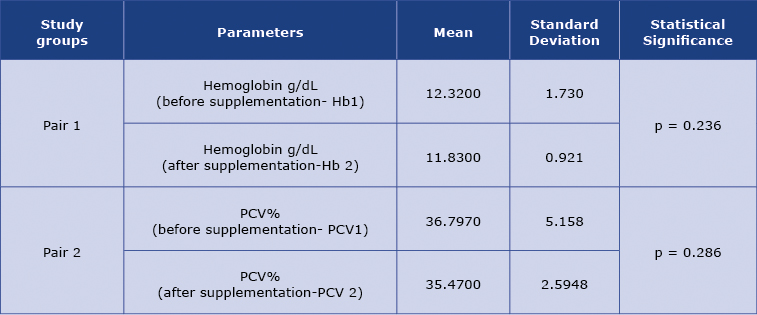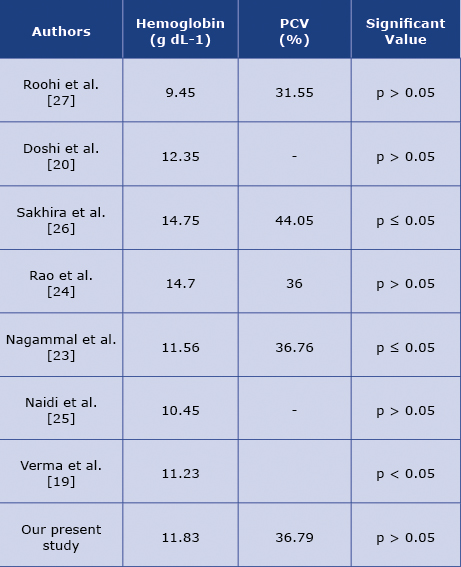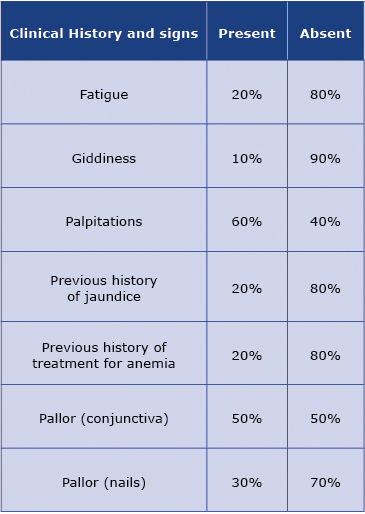Effect of fenugreek seed supplementation on Hemoglobin and PCV among 20-30 years old females: a pilot study
Abstract
Background
Females are more likely than males to suffer from anemia. There have been many studies investigating the nutritional qualities of traditional plants. The of this study was to assess the effect of fenugreek seeds on hemoglobin and PCV values in 20-30 years old females.
Material and methods
Baseline hematological tests were obtained from 10 females aged 20-30 years. Supplementation of the standard amount of fenugreek was given to the population. After 48 days the same hematological parameters were analyzed as a post-test. The results of the pre- and post-test analysis were compared by using a paired-sample t-test. Relevant details were also collected and analyzed.
Results
The mean value of hemoglobin before supplementation (Hb1) and hemoglobin after supplementation (Hb2) was 12.3200 and 11.3300 respectively and the mean value of packed cell volume before (PCV1) and after supplementation (PCV2) was 36.7970 and 35.4700, respectively. This shows that there is a mild decrease in hemoglobin and PCV values after fenugreek supplementation, but not at a statistically significant level.
Conclusions
Within the limitations of our pilot study, we conclude that fenugreek has no significant effect on Hemoglobin and PCV values and can’t be used as an exact supplement to cure anemia.
Citation
M.P. B. Effect of fenugreek seed supplementation on Hemoglobin and PCV among 20-30 years old females: a pilot study. Eur J Transl Clin Med. 2022;5(1):27-32Introduction
Anemia is defined as a decrease in oxygen-carrying capacity and hemoglobin levels from the normal range [1-3]. There are different types of anemia: iron deficiency, hemolytic, aplastic and inflammation-related [4-5]. The most common is iron deficiency anemia and it is becoming increasingly common these days because of lifestyle changes among reproductive females. During this time, physical and psychological activity will be at their peak. The risk of females being neglected by society is higher [6]. The body requires more energy and nutrition during puberty resulting in anemia in about 55% of females around the world [7]. Poverty is also one of the cause of nutritional anemia in females. Furthermore, women have blood loss during their menstrual cycle [8]. Anemia can be diagnosed by looking at the hemoglobin count, red cells count and packed cell volume. The normal value of hemoglobin is 14-16 g/dl, Red cell mass is 4.2-6.7 million cells per microlitre, Hematocrit is 35-48% [9]. Iron deficiency anemia is usually treated with oral iron supplements. Patients are also advised to take regular traditional iron-rich food supplements.
Fenugreek (Trigonella foenum-graecum/methi) is a traditional plant with a high nutritional profile that is commonly used to prevent or treat iron-deficiency anemia in the general population. Predominantly most of the spices of the fenugreek family (Fabaceae) serve as a flavoring agent. Although fenugreek belongs to this family, that doesn't mean it can only be used for cooking. Components of fenugreek include fiber, phospholipids, glycolipids, linolenic acid, choline, vitamins A, B1, B2, C, nicotinic acid, niacin, and other basic elements [10]. Additionally, fenugreek seeds are used in the paper, cosmetic, pickle, beverage, perfume and paint industries. Moreover, they are effective hypoglycemic, hypocholesterotic, and antithrombotic agents. The seeds were thought to contain non-nutritional saponins and alkaloids. Fenugreek seeds lower triglyceride levels as well as total cholesterol levels and also lower the density of lipoprotein cholesterol [11]. It was demonstrated in a study that soluble fibers in fenugreek, including glucomannan fiber, have essential biochemical changes like decreasing the intestinal absorption of glucose and sugars (fenugrecin) and possess hypoglycaemic properties [12]. An extract of Fenugreek at a dose of 400 mg daily yielded a positive correlation with hyperlipidemia reduction in the study. Fenugreek extract shows more than 70% inhibition in the growth of tumour cells on repeated control [13]. Recently, insulin resistance and cholesterol metabolism properties of fenugreek were investigated [14] and fenugreek seeds were found to increase erythropoiesis in broiler breeder males [15]. In a previous study published in 2020, fenugreek seeds reversed anemia [16] in dental outpatients. However, there is only a limited amount of evidence about their effect on anemia in adolescent females. The aim of our study was to assess the effect of soaked fenugreek seeds on hemoglobin levels and packed cell volume (PCV) in clinically healthy 20- 30 year old females.
Materials and methods
In this prospective study, 10 asymptomatic females 20-30 years of age were selected using the random sampling method using a digital laboratory record system. Females during their menstruation period were excluded from the study. Validation of the study was done by expert pathologists and principal investigators. A written consent form was taken from the study participants before initiating the clinical trial. This form was for explaining the purpose of the study and clarifying their queries about the consumption of fenugreek seeds. Details regarding age, height, weight and general health conditions were recorded in all selected participants.
The fenugreek seeds were cleaned, measured for one teaspoon and soaked in 5 ml of water, and left overnight and supplemented before breakfast. On the first day before fenugreek seed supplementation, intravenous blood samples were collected from participants and analysed for hemoglobin and PCV levels. In the following days, the participants consumed fenugreek seeds orally followed by drinking water every day after breakfast. After a consecutive period of time (48 days) the IV samples were collected. Hemoglobin percentage was analyzed using an automated haematology analyzer. Haematocrit (PCV) is the measurement of the proportion of blood that is made up of cells which were obtained as a calculated value from the automated analyzer. Pair 1 represents the mean value of hemoglobin before supplementation (Hb1) and hemoglobin after supplementation (Hb2). Pair 2 represents the mean value of packed cell volume before (PCV1) and after supplementation (PCV2). The obtained haematological data were assessed using the paired t-test via the SPSS Statistics software (IBM, Armonk, USA).
Results
From the results obtained, pair 1 represents the mean value of hemoglobin before supplementation (Hb1) and hemoglobin after supplementation (Hb2) as 12.3200 and 11.3300 respectively with p value - 0.235 (p > 0.05). The pair 2 shows the mean packed cell volume before (PCV1) and after supplementation (PCV2) as 36.7970 and 35.4700 respectively with p value = -0.286 (p > 0.05). [Table 1]. After supplementation, hemoglobin and PCV mean values were decreased. However, were no statistically significant differences in the hemoglobin and PCV measurements before and after fenugreek supplementation.
Table 1. The mean, standard deviation and statistical analysis of Hemoglobin and PCV variations before and after supplementation

Discussion
According to the literature, elemental iron contained in fenugreek seeds was effective at boosting functions such as hemoglobin synthesis, oxygen transportation, regulation of body temperature and muscle activity [17]. Vitamin C in fenugreek leaves improves haemoglobin levels in women who suffer from anaemia [18].
In our study, Hemoglobin concentration before fenugreek supplementation seems higher (mean 12.32 gm/dl) than after 2 months of fenugreek supplementation it was insignificantly reduced (mean 11.83gm/ dl). This is supported by Verma et al., who showed that fenugreek seeds were effective in decreasing glycated hemoglobin levels (HbA1C) in type 2 diabetic patients [19] (see Table 2). Doshi et al. published that fenugreek seeds increased blood hemoglobin levels and treating anemia in childbearing women [20]. Pregnancy-related hemoglobin increases may be caused by the lack of menstruation during this time. In our current study, the hemoglobin level was lower than expected, which is not consistent with our previous findings. Study by Srinivasan et al. showed that fenugreek reduces menstrual blood loss and thereby it increases the hemoglobin level in females of reproductive age [21].
Table 2. Hemoglobin and PCV values obtained from various previous articles

PCV value before supplementation seems high (mean 36.79), when compared with after supplementation values (mean-35.47). Due to a decrease in hemoglobin, the hematocrit level also decreased. In fact, they are directly related as shown in this formula: PCV = 3 x Hb [22]. According to studies conducted by Rao et al. and Nagammal et al., fenugreek increased hemoglobin and PCV values, which is not consistent with our study [23-24]. A study by Naidi et al. compared the effect of fenugreek with glibenclamide drugs in diabetic patients. A higher RBC count was observed in fenugreek (5.44 / mm3), MCV (88.74 fL) and MCH (27.68 pg) when compared to glibenclamide. Apparently, fenugreek seems to stimulate hematopoietic stem cells, thereby improving hemoglobin levels [25-26]. Roohi et al. observed a reduction in hemoglobin and PCV values in their study on fish diet [37]. A study of fenugreek meal on male rats found significant increases in hemoglobin and PCV levels after supplementation [26].
This is a pilot study and its limitations include a small sample size and short follow-up. This can be overcome by recruiting a higher sample size and a year-long fenugreek supplementation in the future. After analyzing the clinical history of the participants (Table 3), it was discovered that the participants who had a the previous history of anemia and were treated with iron supplements had a mildly higher hemoglobin and PCV value than the other participants. These selection biases can be avoided in future studies.
Table 3. Clinical history and examination findings of the study participants

Conclusion
With respect to the limitations of this study, we conclude that fenugreek reduced hemoglobin levels and packed cell volume among clinically healthy females of age 20-30 years. However, this reduction is not statistically significant. The data above shows that consumption of a soaked single teaspoon of fenugreek is not an effective supplementation for increasing hemoglobin and PCV and correcting anemia. This might have promising effects when taken with iron supplements. Further research on fenugreek supplementation is awaiting completion by the author.
Acknowledgements
None Declared.
Funding
None.
Conflicts of interest
None.
References
| 1. |
Shreya S, Brundha MP. Alteration of Haemoglobin Value in Relation to Age, Sex and Dental Diseases-A Retrospective Correlation Study. Res J Pharm Technol [Internet]. 2017;10(5):1363. Available from: http://www.indianjournals.com/ijor.aspx?target=ijor:rjpt&volume=10&issue=5&article=016.
|
| 2. |
Brundha DM, Priyadharshini S. Comparison of haemoglobin estimation by Sahli’s two - time average, Sahli’s three - time average methods and automated analyzer method: A different approach in clinical pathology. Int J Clin Diagnostic Pathol [Internet]. 2019 Jul 1;2(2):291-5. Available from: http://www.patholjournal.com/archives/2019/vol2issue2/E/2-2-46.
|
| 3. |
Brundha MP. A Comparative Study-The Role of Skin and Nerve Biopsy in Hansen’s Disease. J Pharm Sci Res [Internet]. 2015;7(10):837. Available from: https://www.researchgate.net/profile/Brundha-Mp-2/publication/283561218_A_comparative_study-_the_role_of_skin_and_nerve_biopsy_in_hansen’s_disease/links/5892ba5d458515aeac946451/A-comparative-study-the-role-of-skin-and-nerve-biopsy-in-hansens-disease.pdf.
|
| 4. |
Harsha L, Brundha MP. Role of collagen in wound healing. Drug Invent Today [Internet]. 2020 Jan;13(1):55-7. Available from: http://han.gumed.edu.pl/han/ebsco-host/search.ebscohost.com/login.aspx?direct=true&db=asn&AN=141552664&lang=pl&site=eds-live&scope=site.
|
| 5. |
Sheshadri S, Lingaraju GM, Varadarajan R. Denaturant mediated unfolding of both native and molten globule states of maltose binding protein are accompanied by large Δ C p ’s. Protein Sci [Internet]. 1999;8(8):1689-95. Available from: http://doi.wiley.com/10.1110/ps.8.8.1689.
|
| 6. |
Toteja GS, Singh P, Dhillon BS, Saxena BN, Ahmed FU, Singh RP, et al. Prevalence of Anemia among Pregnant Women and Adolescent Girls in 16 Districts of India. Food Nutr Bull [Internet]. 2006 Dec 1;27(4):311–5. Available from: https://doi.org/10.1177/156482650602700405.
|
| 7. |
Chaudhary SM, Dhage VR. A study of anemia among adolescent females in the urban area of nagpur. Indian J Community Med [Internet]. 2008 Oct;33(4):243-5. Available from: https://pubmed.ncbi.nlm.nih.gov/19876498.
|
| 8. |
Ananya R, Brundha M. Comparison of Hb and PCV values in manual methods – a prospective study. Biosc Biotech Res Comm [Internet]. 2020;13(8):196-200. Available from: http://bbrc.in/bbrc/wp-content/uploads/2020/10/BBRC-136.pdf.
|
| 9. |
Ahmad A, Alghamdi SS, Mahmood K, Afzal M. Fenugreek a multipurpose crop: Potentialities and improvements. Saudi J Biol Sci [Internet]. 2016;23(2):300-10. Available from: https://www.sciencedirect.com/science/article/pii/S1319562X15002107.
|
| 10. |
Basch E, Ulbrich C, Kuo G, Szapary P, Smith M. Therapeutic applications of fenugreek. Altern Med Rev [Internet]. 2003;8(1):20-7. Available from: http://inconnate.com/Download/Fenugreek/document3.pdf.
|
| 11. |
Petropoulos GA. Fenugreek: The Genus Trigonella [Internet]. CRC Press; 2002. (Medicinal and Aromatic Plants - Industrial Profiles). Available from: https://books.google.pl/books?id=BKalSd5bInAC.
|
| 12. |
Gupta A, Gupta R, Lal B. Effect of Trigonella foenum-graecum (Fenugreek) seeds on glycaemic control and insulin resistance in type 2 diabetes. J Assoc Physicians India [Internet]. 2001;49:1057-61. Available from: https://www.researchgate.net/profile/Arvind-Gupta-15/publication/11493120_Effect_of_Trigonella_foenum-graecum_Fenugreek_Seeds_on_Glycaemic_Control_and_Insulin_Resistance_in_Type_2_Diabetes_Mellitus_A_Double_Blind_Placebo_Controlled_Study/links/54a778060cf.
|
| 13. |
Khan F, Negi K, Kumar T. Effect of sprouted fenugreek seeds on various diseases: a review. J Diabetes, Metab Disord Control [Internet]. 2018 Aug 2;5(4):119-25. Available from: https://medcraveonline.com/JDMDC/effect-of-sprouted-fenugreek-seeds-on-various-diseases-a-review.html.
|
| 14. |
Kiss R, Pesti-Asbóth G, Szarvas MM, Stündl L, Cziáky Z, Hegedűs C, et al. Diosgenin and Its Fenugreek Based Biological Matrix Affect Insulin Resistance and Anabolic Hormones in a Rat Based Insulin Resistance Model. Jadeja RN, editor. Biomed Res Int [Internet]. 2019 Apr 4;2019:1-13. Available from: https://doi.org/10.1155/2019/7213913.
|
| 15. |
Abdul-Rahman S. Effect of fenugreek seeds on some physiological characters in broiler breeders males. Mesopotamia J Agric [Internet]. 2012 Mar 28;40(0):1-8. Available from: https://magrj.mosuljournals.com/article_62455.html.
|
| 16. |
Ananya B, Rani SL, Brundha MP. Knowledge and attitude of probiotics among outpatients visiting dental operatory. Drug Invent Today [Internet]. 2020 Feb 15;14(2):358-62. Available from: http://han.gumed.edu.pl/han/ebsco-host/search.ebscohost.com/login.aspx?direct=true&db=asn&AN=142963164&lang=pl&site=eds-live&scope=site.
|
| 17. |
Erum S, Rashid A, Masood S. Evaluation of Kasuri methi Trigonella foenumgraecum l. Var. To establish gi right of Pakistan. Pakistan J Agric Res [Internet]. 2011;24(1-4). Available from: https://www.cabi.org/gara/FullTextPDF/2013/20133374598.pdf.
|
| 18. |
Mehrafarin A, Badi HN, Noormohammadi G, Rezazadeh S, Qaderi A. Effects of environmental factors and methanol on germination and emergence of Persian Fenugreek (Trigonella foenum-graecum L.). African J Agric Res [Internet]. 2011;6(19):4631-41. Available from: https://academicjournals.org/journal/AJAR/cited-by-article/4C3A34B38597.
|
| 19. |
Verma N, Usman K, Patel N, Jain A, Dhakre S, Swaroop A, et al. A multicenter clinical study to determine the efficacy of a novel fenugreek seed (Trigonella foenum-graecum) extract (FenfuroTM) in patients with type 2 diabetes. Food Nutr Res [Internet]. 2016 Jan 1;60(1):32382. Available from: https://doi.org/10.3402/fnr.v60.32382.
|
| 20. |
Doshi M, Mirza A, Umarji B, Karambelkar R. Effect of Trigonella foenum-graecum (fenugreek/methi) on hemoglobin levels in females of child bearing age. Biomed Res [Internet]. 2012;23(1):47e50. Available from: https://citeseerx.ist.psu.edu/viewdoc/download?doi=10.1.1.1077.8889&rep=rep1&type=pdf.
|
| 21. |
Srinivasan K. Fenugreek (Trigonella foenum-graecum): A Review of Health Beneficial Physiological Effects. Food Rev Int [Internet]. 2006 Jul 1;22(2):203-24. Available from: https://doi.org/10.1080/87559120600586315.
|
| 22. |
Brundha M. Pregnancy and infections: a review. Int J Clin Correl [Internet]. 2020;4(2):23. Available from: http://www.ijcpc.org/text.asp?2020/4/2/23/301713.
|
| 23. |
Nagamma T, Konuri A, Nayak CD, Kamath SU, Udupa PEG, Nayak Y. Dose-dependent effects of fenugreek seed extract on the biochemical and haematological parameters in high-fat diet-fed rats. J Taibah Univ Med Sci [Internet]. 2019;14(4):383-9. Available from: https://www.sciencedirect.com/science/article/pii/S165836121930071X.
|
| 24. |
Rao PU, Sesikeran B, Rao PS, Naidu AN, Rao VV, Ramachandran EP. Short term nutritional and safety evaluation of fenugreek. Nutr Res [Internet]. 1996;16(9):1495-505. Available from: https://www.sciencedirect.com/science/article/pii/0271531796001637.
|
| 25. |
Najdi RA, Hagras MM, Kamel FO, Magadmi RM. A randomized controlled clinical trial evaluating the effect of Trigonella foenum-graecum (fenugreek) versus glibenclamide in patients with diabetes. Afr Health Sci [Internet]. 2019 Apr 18;19(1):1594. Available from: https://www.ajol.info/index.php/ahs/article/view/185747.
|
| 26. |
Mbarki S, Alimi H, Bouzenna H, Elfeki A, Hfaiedh N. Phytochemical study and protective effect of Trigonella foenum graecum (Fenugreek seeds) against carbon tetrachloride-induced toxicity in liver and kidney of male rat. Biomed Pharmacother [Internet]. 2017;88:19-26. Available from: https://www.sciencedirect.com/science/article/pii/S0753332216311544.
|
| 27. |
Roohi Z, Imanpoor MR, Jafari V, Taghizadeh V. The use of fenugreek seed meal in fish diets: growth performance, haematological and biochemical parameters, survival and stress resistance of common carp (Cyprinus carpio L.). Aquac Res [Internet]. 2017 Mar 1;48(3):1209-15. Available from: https://doi.org/10.1111/are.12962.
|









